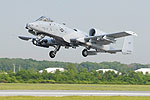Lawmakers: Hold off on A-10 cuts
 A bipartisan group of lawmakers last week urged Defense Department leaders to hold off on any plans to cut the A-10 and provide more scrutiny to the Air Force’s budget plans.
A bipartisan group of lawmakers last week urged Defense Department leaders to hold off on any plans to cut the A-10 and provide more scrutiny to the Air Force’s budget plans.
The letter, signed by 13 senators and 20 representatives, calls on Defense Secretary Chuck Hagel and Army Gen. Martin Dempsey, chairman of the joint chiefs of staff, to “actively scrutinize” the Air Force’s fiscal 2015 budget proposals, and conduct a study on close-air support as directed by the Senate Armed Services Committee in its report on the fiscal 2014 authorization bill.
“In terms of maintaining the health of the A-10 fleet with pilot training, sufficient flight hours, utilization of active component squadrons, software upgrades, and modernization funding, it is essential that the Air Force not take any additional steps toward divestment,” the Nov. 14 letter states. “It is also important that the Air Force reverse any actions taken in recent months that could make an A-10 divestment a foregone conclusion before Congress can exercise its constitutional oversight role.”
Earlier this year, Air Force leaders said they were considering cutting entire fleets of “single-mission aircraft,” including the A-10 ground attack jet and the KC-10 tanker plane.
“Only by divesting entire fleets (vertical cuts) will we achieve savings measured in billions rather than ‘just’ millions of dollars,” the Air Force said last month in response to questions from Sen. Kelly Ayotte, R-N.H. “Additionally, the savings from an entire fleet divestiture prevents the AF from having to eliminate newer, more capable, multi-role aircraft such as the F-16 or F-35.”
The Air Force statement to Ayotte estimates that the service could save about $3.5 billion over five years by cutting the entire A-10 fleet. It also said other aircraft, such as the F-15E and B-1B, can handle the close-air support role, but noted any plans to cut the fleet are “pre-decisional.”
In the letter, the lawmakers wrote that the A-10 is the service’s most capable aircraft at providing close-air support. Cutting the airframe would create a close-air support “gap that would reduce Air Force combat power and unnecessarily endanger our service members in future conflicts.”